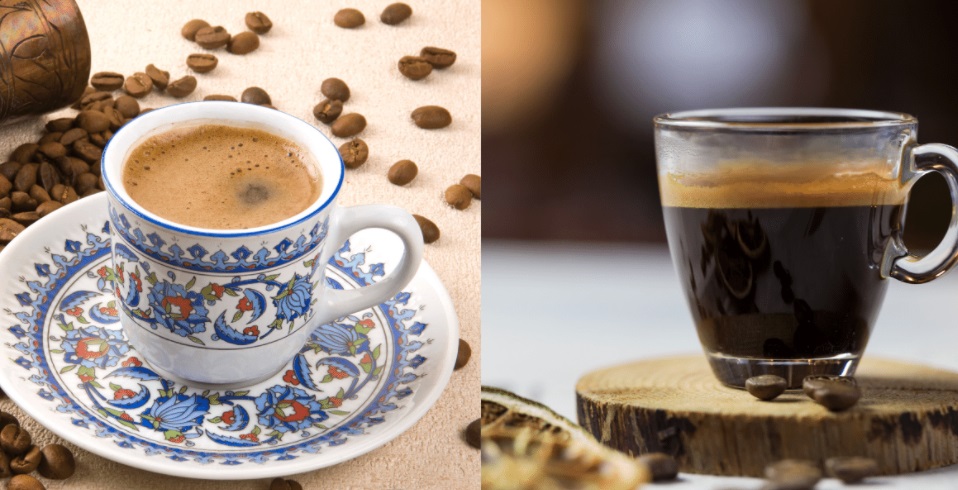
Turkish coffee and American coffee stand as icons of their respective cultures, each with unique brewing techniques and a rich heritage. Turkish coffee is renowned for its intense flavor and fine grounds, traditionally brewed in a small pot called a cezve. This method involves boiling finely ground coffee with water and sugar, often spiced with cardamom, and serving it in small cups, where the grounds settle but remain in the cup.
American coffee, typically made using a drip brew method, offers a lighter taste and is usually served in larger, more casual quantities. This contrast not only highlights diverse cultural approaches to coffee but also shows how each has developed a distinct identity and role within its society.
Key Takeaways
- Turkish Coffee: Strong, rich, and finely ground, served in small quantities with a distinctive foam.
- American Coffee: Generally lighter, brewed via drip, and served in larger amounts.
- Cultural Impact: Both types of coffee have unique preparation and consumption practices that reflect their cultural importance.
Brewing Methods: Turkish Coffee
The preparation of Turkish coffee is almost as ritualistic as it is a brewing method. Using a cezze, a small long-handled pot, coffee is ground to a fine powder. Water—and often sugar and spices—are added, and the mix is heated until frothy. It’s served directly in a cup, allowing the grounds to settle at the bottom. This technique results in a coffee that is much stronger and richer in flavor, typically consumed in smaller servings that emphasize its intensity.
American Coffee
In contrast, American coffee is usually prepared using a drip brew technique. Water is heated and slowly filtered through coffee grounds contained in a paper or metal filter. This method is favored for its convenience and ability to serve more people quickly. The resulting coffee is relatively lighter in flavor and body, often enjoyed in large mugs throughout the day to sustain energy levels.
Flavor and Texture
Turkish coffee is famed for its potent and rich flavor profile, achieved through its unique brewing technique. As the coffee grounds are boiled together with water and often sugar, they fuse to create a thick, intense drink with a texture that’s almost syrupy. Traditionally, spices such as cardamom may be added, enhancing the coffee’s robustness. This results in a concentrated flavor that can be described as bold and earthy, with a slight bitterness that lingers on the palate.
On the other hand, American coffee presents a spectrum of flavors depending on the beans and the brew method. Ranging from fruity to nutty, or even chocolatey, American coffee’s flavor is lighter and varies widely. This variety is due to the different roasts and origins of the beans used, as well as the brewing process, which allows for a cleaner and clearer taste. The texture is generally smoother and less dense than Turkish coffee, appealing to those who enjoy sipping their coffee over extended periods.
Caffeine Content
When it comes to caffeine, the contrast between Turkish and American coffee might surprise many. Despite its stronger flavor, a standard serving of Turkish coffee contains less caffeine than a typical American coffee cup due to serving sizes. Turkish coffee is usually served in small amounts—about 2-3 ounces—with each serving containing roughly 50 milligrams of caffeine. In comparison, a standard 8-ounce cup of American drip coffee can contain about 95 milligrams of caffeine.
Cultural Significance
In Turkish culture, coffee is more than just a beverage; it’s a ceremonial act of hospitality, friendship, and tradition. Serving Turkish coffee is an intimate gesture, often accompanied by a long conversation. The preparation process itself is considered an art form, meant to be savored just as much as the drink. In many Turkish households, coffee follows meals and plays a central role in engagements and weddings, symbolizing a commitment to hospitality and meticulous care.
In contrast, the “coffee break” is a staple of American workplace culture, symbolizing a brief respite from the day’s duties. It’s a time for colleagues to gather and share a moment of relaxation. This break is not just about drinking coffee but also about socializing and recharging. American coffee culture promotes convenience and accessibility, with coffee chains and home coffee machines making it easy to enjoy a cup of coffee at any time of day.
Consumption and Serving Practices
Turkish coffee is traditionally served in small cups, similar to espresso but with a much richer texture. It is often prepared with sugar cooked into the brew and is sometimes spiced with cardamom. The coffee is served with the grounds settled at the bottom of the cup, a reminder of its unfiltered tradition. Turkish delight or a piece of chocolate might accompany the coffee, balancing its deep flavors with a touch of sweetness.
American coffee, meanwhile, is typically served in larger cups and mugs, with options for customization like sugar, cream, and various syrups to suit individual tastes. The serving style caters to the on-the-go lifestyle, with disposable cups for easy transport. The emphasis is on personalization and efficiency, allowing each drinker to tailor their coffee experience, whether at home or from a coffee shop.
FAQs
How do I brew Turkish coffee at home? To brew Turkish coffee, you’ll need a cezve or a small pot. Start by adding finely ground coffee and cold water (sugar is optional) to the cezve. Heat it over low heat until it starts to froth but not boil. Remove from heat just before boiling and allow to settle a bit before serving.
How do I make American coffee at home? For American coffee, a drip coffee maker or a pour-over setup works best. Measure your ground coffee into the filter (about 1 to 2 tablespoons per 6 ounces of water), add water to the machine, and start the brew. Adjust the coffee-to-water ratio according to how strong you like your coffee.
What are the health benefits of each? Both Turkish and American coffee offer benefits like antioxidants and may reduce the risk of certain diseases. However, Turkish coffee can be more beneficial due to its unfiltered nature, preserving more nutrients and compounds.
How do I choose between Turkish and American coffee? It really comes down to personal preference. If you enjoy a strong, rich flavor with a bit of sediment, go for Turkish coffee. If you prefer a smoother, lighter cup you can sip throughout the day, American coffee might be your choice.
Final Thoughts
Throughout our exploration of Turkish and American coffee, we’ve seen how each brew reflects its cultural backdrop and offers a unique coffee experience. Turkish coffee, with its strong, rich flavors and communal brewing rituals, offers a moment of togetherness and reflection. American coffee, on the other hand, caters to efficiency and customization, providing a comforting routine that fuels the daily grind.
The choice between Turkish and American coffee often boils down to personal taste preferences and the kind of coffee experience you are seeking. Whether you’re drawn to the robust intimacy of Turkish coffee or the versatile and accessible nature of American coffee, each cup offers a window into a rich cultural tradition and a distinct set of flavors and brewing methods.









